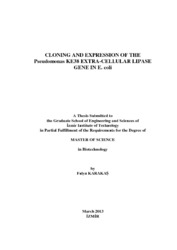Please use this identifier to cite or link to this item:
https://hdl.handle.net/11147/3598Full metadata record
| DC Field | Value | Language |
|---|---|---|
| dc.contributor.advisor | Arslanoğlu, Alper | - |
| dc.contributor.author | Karakaş, Fulya | - |
| dc.date.accessioned | 2014-07-22T13:51:55Z | - |
| dc.date.available | 2014-07-22T13:51:55Z | - |
| dc.date.issued | 2013-03 | - |
| dc.identifier.uri | http://hdl.handle.net/11147/3598 | - |
| dc.description | Thesis (Master)--Izmir Institute of Technology, Biotechnology, Izmir, 2013 | en_US |
| dc.description | Includes bibliographical references (leaves. 27-31) | en_US |
| dc.description | Text in English; Abstract: Turkish and English | en_US |
| dc.description | ix, 33 leaves | en_US |
| dc.description | Full text release delayed at author's request until 2015.05.02 | en_US |
| dc.description.abstract | Lipases are serine hydrolases that catalyze both the hydrolysis and synthesis of insoluble or poorly soluble long-chain triacylglycerols with an acyl chain length ≥ 10 carbon atoms based on the presence or absence of water. Lipases are produced and secreted by all kingdoms of life that are eukaryotes including plants, animals, fungi and prokaryotes including bacteria and archaea. However, microbial lipases, especially from bacteria, more useful than their plant and animal derivatives because of several important properties. Because of their acitivities in both aqueous and nonaqueous environments, lipases have specific applications in industry and medicine. The primary goals of this thesis were to clone and express the extra-cellular lipase gene from Pseudomonas sp. KE38, isolated from soil samples of Erciyes mountain in Kayseri, in E. coli and partial purification of the gene product. To achieve this aim, genome walking technique was used to obtain lipase gene from Pseudomonas sp. KE38, that gene was then cloned into pET28a expression vector and expressed in E. coli. The lipase expression of E. coli BL21 and its activity was screened with olive oil-Rhodamin B plate assay. After expression recombinant lipase was partially purified via inclusion body isolation. Moreover the optimum lipase production time of E. coli BL21 cells were determined and analyzed with SDS-PAGE. According to SDS-PAGE analysis the recombinant lipase was approximately 64 kDa and lipase production reached to the highest level after two hours of IPTG induction. As conclusion, recombinant lipase from Pseudomonas sp. KE38 was cloned into E. coli, expressed and partially purified. | en_US |
| dc.language.iso | en | en_US |
| dc.publisher | Izmir Institute of Technology | en_US |
| dc.rights | info:eu-repo/semantics/openAccess | en_US |
| dc.subject.lcsh | Lipase--Biotechnology | en |
| dc.subject.lcsh | Molecular cloning | en |
| dc.subject.lcsh | Escherichia coli | en |
| dc.subject.lcsh | Pseudomonas | en |
| dc.title | Cloning and Expression of the Pseudomonas Ke38 Extra-Cellular Lipase Gene in E. Coli | en_US |
| dc.type | Master Thesis | en_US |
| dc.institutionauthor | Karakaş, Fulya | - |
| dc.department | Thesis (Master)--İzmir Institute of Technology, Bioengineering | en_US |
| dc.relation.publicationcategory | Tez | en_US |
| dc.identifier.wosquality | N/A | - |
| dc.identifier.scopusquality | N/A | - |
| item.grantfulltext | open | - |
| item.fulltext | With Fulltext | - |
| item.languageiso639-1 | en | - |
| item.openairetype | Master Thesis | - |
| item.cerifentitytype | Publications | - |
| item.openairecristype | http://purl.org/coar/resource_type/c_18cf | - |
| Appears in Collections: | Master Degree / Yüksek Lisans Tezleri | |
Files in This Item:
| File | Description | Size | Format | |
|---|---|---|---|---|
| 10000160.pdf | MasterThesis | 940.27 kB | Adobe PDF |  View/Open |
CORE Recommender
Page view(s)
262
checked on Jun 16, 2025
Download(s)
128
checked on Jun 16, 2025
Google ScholarTM
Check
Items in GCRIS Repository are protected by copyright, with all rights reserved, unless otherwise indicated.